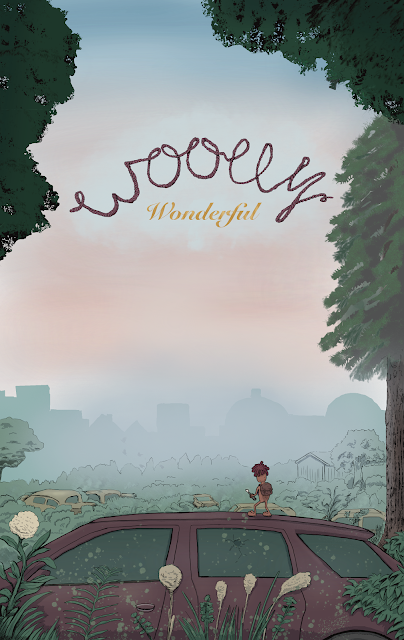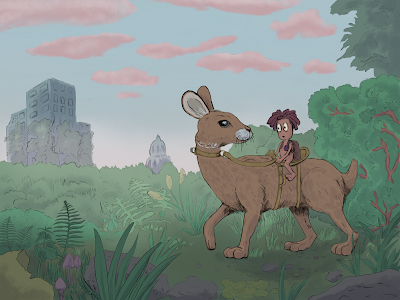Animal Advent Calendar - 4th Advent
Welcome back to the Animal Advent Calendar on the 4th Advent. We will be looking at what sketches I did for animals starting with letters P - V.
P for Philippine Eagle
The Philippine eagle lives only on the islands of the Philippines and is the largest eagle followed by the bald eagle from North America, though not as famous. It grows to 1 m length and 7 kg of weight, it also features a nice, extravagant hairdo.
They feed on all sorts of medium sized animals like civets, squirrels, deer, birds, lizards, snakes and monkeys. The latter prey brought them their other name, “monkey-eating eagle”, as people have observed them hunting monkeys. Couples hunt together, while one distracts the monkey herd from the front , the other one strikes from the back.
Philippine eagles mate for life and only produce one offspring every two years which they nurture 20 months. This slow breeding cycle and their slow maturity of 3-7 years, the eagle is threatened. Human factors like deforestation, mining, agriculture and pesticides contribute to its decline.
Q for Quokka
I initially didn’t want to do the letter Q because there are not many animals, but those ones that exist are pretty cool.
Like the Quokka. This ever smiling little Kangaroo from Western Australia.
They indeed have a happy resting face which has lured a lot of tourists to take selfies with them. And catapulted them to internet darlings in the last 10 years through social media. Although they are herbivores it is important to remember these are wild animals and they will bite.
Quokkas only live around Perth on the south-west corner of Australia. Their past range was vaster than before the arrival of human settlers. The introduction of the red fox through European settlers and also predation through dogs, cats, dingoes and birds of prey shrink their population.
R for Black Rhino
Black rhinos are not actually black, but more greyish. With that out of the way, black rhinos had the greatest range in distribution across Africa, from sub Sahara to South Africa. Nowadays they only exist in little spots of their former range.
They are different from white rhinos by having a hook-shaped, prehensile upper lip instead of a wide mouth. Indeed this mouth shape helps them to be browsers compared to the grazing white rhinos. They are mostly active in the morning, evening and night to escape the midday heat.
Though they are more abundant and wide spread, their numbers are shrinking due to poaching and habitat loss. Especially Asia uses their horn in traditional medicine. Someone might tell the poachers that a living animal is more worth than a dead one.
Currently there are more than 6000 animals left. Females might only breed every 4 years, and with a gestation length of 15 months and just one offspring, they have a pretty slow reproduction cycle. Luckily conservation efforts and protection is strongly focused on saving this species.
S for Secretary Bird
These are 1.3m tall birds of prey, and are apparently called this way because of the black quills at the back of their head. And secretaries from the 19th century put their quills behind the ear when not writing, so the birds reminded them of these.
Despite being able to fly, they rather walk than fly, around 20 to 30 km per day. They prey on snakes, reptiles and little mammals. They kill with a strong strike with their legs, putting 4 times more weight than their own on the poor target. They even hunt for venomous snakes, aiming for the neck to stun or kill them directly before gulping them up.
T for Malayan Tapir
Just when you think the elephant is the only animal with a trunk, I'll present you the Tapir.
There are 4 different species of tapirs in the world, 3 of them live in Central and South America, whereas the Malayan Tapir, also called the Asian Tapir, lives at the other end of the world in Asia, specifically in Indonesia, Thailand, Malaysia and Myanmar.
Tapirs are often called as the oldest living mammal or that they haven't changed much of their body plans for 30 million years. And indeed they look a bit prehistoric with the short trunk. The rest of the body reminds a bit of a rhino or pig.
That trunk helps them grab plants from underwater which these animals mainly feed on when they go for a swim. These tapirs are mainly active at night and hide in the shade of the dense forests they live in during the day. Their black and white coat helps in hiding by breaking up their silhouette. Juveniles instead have a brown coat with white stripes which fades away after 6 months.
These tapirs are quite huge, 2.5 metres long and 500kg heavy. Despite their imposing statue they are threatened due to deforestation (again) for, e.g. palm oil plantations and human expansion.
U for Umbrella Bird
This umbrella bird lives in the western parts of Columbia and Ecuador in high-altitude, humid rainforests. We know a lot of birds with wattles hanging from their neck, but these guys just steal the show. Males have longer wattles than females, which might not have one at all. The wattle is actually fleshy but covered in feathers and can be contracted and extracted. It can be longer than the bird's height and spread out to impress the females.
Many males gather at certain sites every year to compete over the females. While sitting on tree branches and showing off their wattle, they make booming calls, astonishingly low for such a little bird.
Especially these recurring mating sites are a danger to the bird's future. Poachers easily find and remember these spots and trap the birds to sell them for the exotic pet trade or for meat. There might be just around 10k to 20k animals left.
V for Vaquita
Vaquitas are small porpoises from the golf of California around Mexico, related to dolphins.
They can be recognised by their black markings around the eye and the lips, giving them an ever smiling face.
These animals have only been discovered in 1958 and yet they are heading to extinction. There are indeed only 10 left.
They often end up as bycatch or entangled in fishing nets and drown. They unfortunately share waters with the totoaba fish which is highly sought after in Chinese medicine. It is believed they its swim bladder cures diseases. The swim bladders are trafficked to the US and shipped over to China where 1 kg can get prices of several thousand dollars.
Another example of human ignorance, superstition and greed disturbing ecosystems and removing animals from the face of the earth. The Mexican government has released a ban on using fishing gills years ago, but illegal fishing activities have continued.
-----
What is Animal Advent Calendar? For every day in December until the 26th I will post a picture of animal sketches on Instagram for every letter of the alphabet.
Come back for the last batch of animals after Christmas. Check out Instagram for daily advent calendar posts: https://www.instagram.com/andi_pasti_art/
Stay curious,
Andi Pasti










Comments
Post a Comment